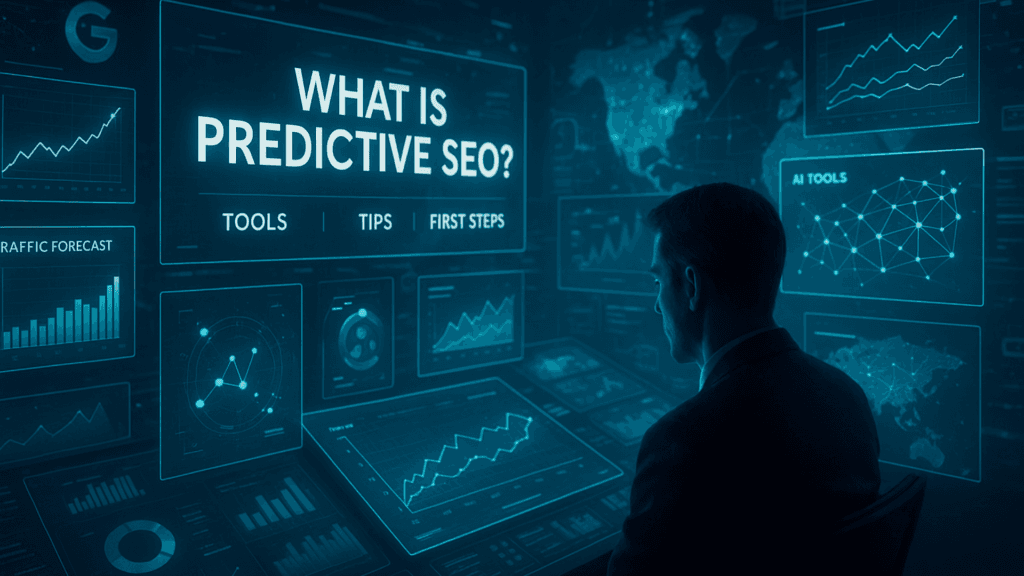What Is Predictive SEO: Tools, Tips & First Steps
Learn how Predictive SEO works, how AI forecasts search trends, and how you can start optimizing your website for future user intent with the right tools and tips.
24/11/2023
Digital Marketing
Table of Content
- What is Predictive SEO?
- The Concept of Predictive SEO
- How Does Predictive SEO Work Exactly?
- How Does AI Predict Search Trends?
- The Benefits of Predictive SEO
- Predictive SEO and E-Commerce: A Perfect Match
- Use Case: Predictive SEO for an International Eyewear Chain
- Challenges & Risks of Predictive SEO
- How to Optimize for Future Searches
- Should I Focus on Predictive SEO?
- How Predictive SEO Aligns with Emerging AI-Driven Trends
- Practical Tips for Implementing AI Tools in Predictive SEO
- Getting Started with Predictive SEO
- Final Thoughts
- FAQs about Predictive SEO
What is Predictive SEO?

Predictive SEO refers to the use of data analytics, machine learning, and AI to forecast future search trends and user behavior—allowing marketers to optimize content before a topic peaks in popularity. Unlike traditional SEO, which reacts to current or historical data, predictive SEO enables proactive strategies.
By leveraging predictive analytics and AI, businesses can anticipate rising keywords, align content with upcoming trends, and create a first-mover advantage on SERPs.
The Concept of Predictive SEO
The core concept behind predictive SEO is anticipation—knowing what users will search for tomorrow, next month, or even next year. It combines:
- Historical data
- Behavioral trends
- Search engine signals
- Real-time data from social platforms
Marketers can forecast keywords and tailor strategies to capture future demand, giving them a critical edge over competitors.
How Does Predictive SEO Work Exactly?
Predictive SEO uses a blend of AI, big data, and natural language processing (NLP) to interpret trends across platforms like Google Trends, Reddit, YouTube, TikTok, and more. It involves:
- Trend mining: Identifying emerging search terms
- Sentiment analysis: Understanding user emotions and opinions
- Pattern recognition: Spotting repeating seasonal or behavioral cycles
- Content mapping: Creating content before the demand spikes
For example, an AI tool might recognize increasing chatter about “smart sunglasses” across forums and start tracking its growth rate—helping a marketer publish content on it before it peaks.
How Does AI Predict Search Trends?
AI analyzes billions of data points to recognize emerging behavioral patterns. Here’s how:
- Natural language models evaluate the way users ask questions
- Predictive algorithms track keyword rise/fall velocity
- Search engine logs show recurring long-tail keyword trends
- Social signals (shares, hashtags, mentions) indicate rising topics
This isn’t just about keywords—it’s about intent. AI tools look beyond the “what” and into the “why,” allowing brands to serve users better.
The Benefits of Predictive SEO
Adopting predictive SEO offers several clear advantages:
- Early-mover advantage: Rank before the competition even knows the trend exists
- Improved content planning: Build editorial calendars around forecasted demand
- Higher ROI: Focus on future high-converting topics
- Better user experience: Address user needs before they even fully realize them
- Adaptive strategy: Stay ahead of search engine updates and algorithm shifts
Predictive SEO and E-Commerce: A Perfect Match
For e-commerce brands, predictive SEO is transformative. Imagine forecasting next season’s trending styles, product queries, or concerns.
For instance, an e-commerce store selling footwear can:
- Spot rising demand for “plant-based sneakers”
- Prepare blog content and product landing pages in advance
- Dominate SERPs by the time the trend becomes mainstream
Predictive SEO ensures inventory, content, and campaigns are aligned before competitors catch up.
Use Case: Predictive SEO for an International Eyewear Chain
An international eyewear brand used predictive SEO to identify a growing interest in “blue light blocking glasses for kids.
Strategy:
- AI analyzed parent forums, social media, and regional search data
- The content team created blog posts, videos, and product pages around the topic
- Influencer partnerships boosted visibility
Results:
- 200% traffic increase within 60 days
- Product pages ranked on page 1 of Google ahead of competitors
- Sales of kids’ blue light glasses rose by 45% quarter-over-quarter
This demonstrates how predictive SEO can translate into real business growth.
Challenges & Risks of Predictive SEO
While powerful, predictive SEO isn’t without challenges:
- Data dependency: Inaccurate or limited data can lead to wrong forecasts
- Tool complexity: Advanced tools require training and interpretation
- Resource allocation: Investing in future trends can divert focus from current performance
- Over-optimization: Creating content too early may miss timing alignment
Balancing future-focused efforts with present-day needs is critical.
How to Optimize for Future Searches
Future-proofing your content requires a strategic shift:
- Monitor emerging platforms (like TikTok, Threads, and Reddit)
- Use trend tools like Exploding Topics, Google Trends, Glimpse, and BuzzSumo
- Perform intent analysis on evolving keywords
- Invest in evergreen plus predictive content hybrids
- Create adaptable content frameworks that can be updated quickly
Focus on topic clusters that can scale as the trend grows.
Should I Focus on Predictive SEO?
If your brand thrives on content velocity, trend leadership, or e-commerce visibility, the answer is yes.
Here’s a simple self-check:
- Do you rely on organic search for leads or sales?
- Do you want to own emerging market niches before your competitors?
- Are you already using AI or interested in integrating it?
If you answered yes to any of the above, predictive SEO should be part of your strategy.
How Predictive SEO Aligns with Emerging AI-Driven Trends
The rise of AI content generation, voice search, and smart assistants makes predictive SEO more relevant than ever.
- Conversational AI demands new content formats
- Voice queries require anticipating how people speak, not just type
- AI search engines (like Perplexity or ChatGPT Search) reward timely, relevant content that answers emerging questions
Predictive SEO ensures you’re optimized for the next wave of search behavior.
Practical Tips for Implementing AI Tools in Predictive SEO
Here’s how to get started:
- Pick the right tools:
- Exploding Topics
- Google Trends
- Semrush’s Keyword Magic Tool
- MarketMuse or Clearscope
- ChatGPT for idea generation
- Exploding Topics
- Train your team: Ensure writers, SEOs, and strategists understand predictive workflows
- Use AI to draft skeleton content: You can generate outlines or first drafts based on forecasted topics
- Implement dynamic content updates: Keep content fresh with periodic AI-driven refreshes
- Test & track results: Monitor how early content performs compared to reactive content
Getting Started with Predictive SEO
Starting with predictive SEO involves mindset, tools, and execution:
- Mindset: Be proactive, not reactive
- Tools: Use AI-based forecasting tools to identify trends
- Execution: Build a calendar that includes predicted topics 3–6 months ahead
Your first steps:
- Choose a predictive keyword tool
- Analyze trends in your industry
- Identify 3-5 rising keywords
- Create 1 blog post and 1 landing page per keyword
- Track impressions and SERP rankings weekly
Within weeks, you’ll have data proving whether predictive SEO works for you—and if you’re ahead of the competition.
Final Thoughts
Predictive SEO is no longer a futuristic concept—it’s happening now. As AI and search algorithms evolve, staying ahead of search demand is the key to sustained growth. The earlier you adopt, the greater your competitive edge.
So, whether you’re running a growing blog, managing an e-commerce brand, or building content strategies for enterprises, now is the time to integrate predictive SEO into your playbook.
FAQs about Predictive SEO
Predictive SEO is the process of using data, analytics, and AI to anticipate future search trends. It allows businesses to create and optimize content before users start searching for specific topics or keywords.
Traditional SEO focuses on current or past search behavior, while predictive SEO focuses on forecasting future trends. Predictive SEO is proactive, using AI and trend analysis to rank for keywords before they peak in popularity.
Yes, because you’re targeting emerging trends before they become saturated. This can lead to faster rankings, higher traffic, and lower competition compared to chasing established keywords.
Some powerful tools for predictive SEO include:
- Exploding Topics
- Google Trends
- Glimpse
- BuzzSumo
- Semrush Keyword Trends
- ChatGPT (for trend-based idea generation)
No, it’s beneficial for businesses of all sizes. In fact, small and mid-sized companies can gain a competitive edge by being agile and publishing content ahead of industry giants.
Ideally, review and update it every 30 to 60 days. Trends evolve, and content that ranked early may need optimization to stay relevant and maintain SERP position.
Industries with fast-changing trends benefit the most, including:
- E-commerce
- Fashion & Lifestyle
- Health & Wellness
- Tech & Gadgets
- Finance & Crypto
Travel & Events
Look at the trend’s growth rate, volume potential, and alignment with your audience or products. Use data from tools like Google Trends or Exploding Topics to evaluate trend sustainability before committing.
Yes. Tools like ChatGPT, Jasper, or Writesonic can help you quickly generate first drafts, outlines, or title ideas for predicted topics—just ensure human editing for accuracy and tone.
There’s a slight risk if a predicted trend doesn’t take off. However, by using reliable data and starting with low-investment content (like blog posts), you can minimize the downside while positioning for high upside gains.
